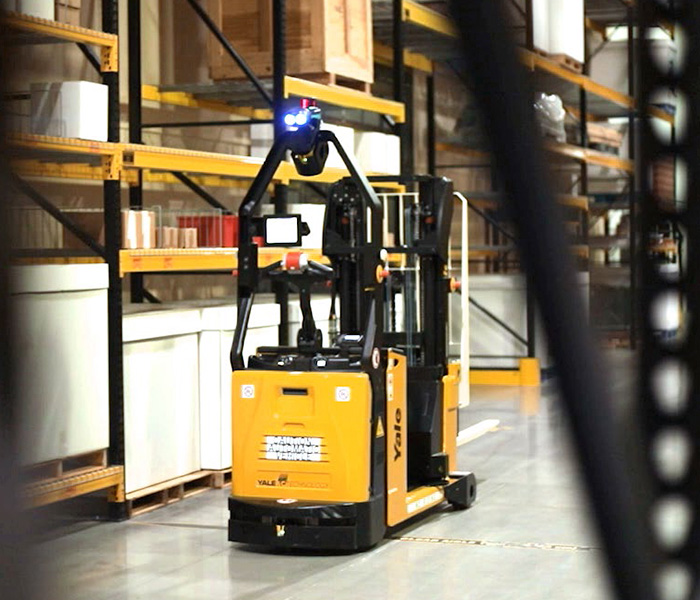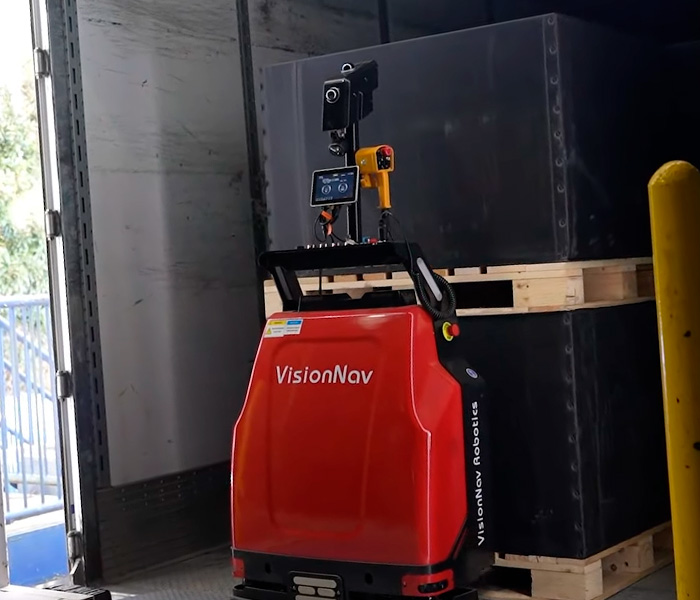Autonomous Solutions
2025 Warehouse Automation Trends
April 9, 2025
Advanced automation technologies are increasingly gaining popularity in the warehouse sector thanks to their ability to drive efficiency, safety and transparency. As more facilities transform their operations with automated tools, experts project the global warehouse automation market will reach nearly CA$60 billion in 2027.
Several technologies, from software programs to high-tech sensors, are helping warehouses reduce the need for manual processes and embrace autonomous procedures. As a warehouse manager, understanding the latest trends can help you stay competitive and improve your daily operations for greater profitability and optimized workflows.
Interested in seeing what the future will bring? Explore the top warehouse automation trends for 2025 below.
1. Warehouse Management Systems
A robust warehouse management system (WMS) is essential for businesses in 2025. These software solutions support daily operations, allowing your team to monitor and enhance important processes effectively.
A WMS can help your team automate the following:
- Inventory management: An advanced management system helps teams track stock levels.
- Order fulfillment: A WMS allows for optimized picking and packing processes.
- Receiving and putaway: Warehouses can leverage a WMS to streamline purchase order verification and inventory storage.
- Workforce scheduling: Managers can use a WMS for labour management, including scheduling labour based on demand. These solutions can also monitor worker performance metrics.
- Shipping operations: WMS tools enable teams to autonomously generate shipping labels and documentation for orders.
Key advantages of WMS include:
- Improved accuracy: Your warehouse can leverage a WMS to track inventory in real time while reducing human error and discrepancies.
- Lower labour costs: Automated tools in these systems can reduce human labour requirements and associated expenses.
- Increased efficiency: Working with a WMS can streamline processes like picking, packing and shipping to support overall efficiency.
2. Automated Storage and Retrieval Systems
Your warehouse can leverage an automated storage and retrieval system (AS/RS) to enhance goods storage, retrieval and overall management.
These warehouse automation solutions are increasingly in demand as online shopping continues to surge, and consumers expect faster order fulfillment. An AS/RS enables quicker and more accurate processing by utilizing advanced technologies, such as radio frequency identification. These systems also benefit warehouses by collecting data that can inform decision-making and continuous improvement efforts.
AS/RS is a type of goods-to-person (GTP) technology that uses automated equipment and software systems to assist warehouse workers in order processing to drive efficiency. By automating physically demanding tasks, workers can experience less strain and improved safety.
3. Automated Guided Vehicles
A major warehousing trend for 2025 is leveraging automated guided vehicles (AGVs) to improve storage and retrieval operations.
AGVs can autonomously navigate warehouses and tackle important processes, including transporting and storing loads. This equipment allows businesses to reduce manual labour and associated costs while driving productivity. Teams can increase throughput by using AGVs to operate around the clock without requiring regular breaks like human workers.
There are various automated forklift models to increase operational efficiency, reduce accident risks and lessen reliance on human labour.
In addition to improved warehouse safety, AGVs can also be reprogrammed to meet evolving warehouse needs, supporting scalability, flexibility and growth.
4. Autonomous Mobile Robots
Autonomous mobile robots (AMRs) are quickly becoming a must-have technology for automating warehouse operations. The global market for AMRs is growing rapidly, with a compound annual growth rate of 22.6% between 2024 and 2032.
While AMRs are similar to AGVs, they don’t follow predefined paths. Instead, they adapt to real-time environmental conditions using simultaneous localization and mapping technologies, LiDAR, sensors and advanced cameras to navigate the facility.
Robotics are essential for warehouses in several industries, from third-party logistics to pharmaceuticals, that want to stay competitive and drive profitability. They offer enhanced order accuracy and support warehouse optimization by collecting valuable performance data during operation. Like AGVs, AMRs also increase warehouse safety and efficiency.
5. Wearable Technologies
Another top automation trend of 2025 is wearable warehouse technology, including:
- Smart glasses: Smart glasses with augmented reality tools enable workers to access essential data and information without physical paperwork or hand-held devices.
- Smart gloves: These advanced solutions enable automatic alerts and task instruction using sensors that recognize operator hand gestures. They can support advanced hands-free control over devices and systems.
- Health monitoring sensors: Health and safety monitoring wearables can automatically collect worker data, including vital signs and ergonomic factors, to combat fatigue and injury risk.
These technologies automatically collect important worker data and enable teams to complete tasks faster by reducing the touchpoints required to fulfill their daily duties. Warehouses can enjoy several benefits from integrating wearable technologies, including:
- Improved picking and packing accuracy.
- Enhanced communication between workers.
- Real-time data and analytics on worker performance.
6. Automated Sortation Systems
Automated sortation systems are critical to modern warehouse operations. They efficiently and accurately sort products and route them to their designated destination within the facility.
This warehouse automation technology is becoming increasingly sophisticated to meet the demands of competitive and faster order fulfillment. These systems streamline operations through high-speed sorting, enabling teams to process large volumes of goods in less time than manual operations. Boosted efficiency with automated sortation systems means reduced labor costs and increased throughput for greater profitability.
Automated sortation systems also enable versatile sorting methods, including:
- Conveyor systems.
- Cross-belt sorters.
- Tilt-tray sorters.
7. Pick-to-Light Systems
Pick-to-light systems are advanced warehouse automation solutions created to optimize order-picking accuracy and efficiency. This technology leverages visual cues to help workers through the picking process and deliver real-time data tracking capabilities to:
- Monitor speed.
- Identify potential bottlenecks.
- Support informed decision-making.
Two major factors contributed to the increase in demand for pick-to-light systems — ongoing labour shortages and rapid e-commerce growth. These solutions help warehousing operations reduce errors and maximize productivity to streamline fulfillment processes and ultimately improve customer satisfaction.
Warehouses can use pick-to-light systems to reduce physical labor demands, enhance safety and improve your team’s job satisfaction.
8. Goods-to-Person Technologies
GTP fulfillment is another growing solution for automating warehouse operations in 2025. These advanced solutions streamline daily picking processes by delivering items to workers rather than having them travel to the facility to seek them out. GTP technologies typically integrate with AS/RS or AMRs to decrease human labour requirements, reducing time and fatigue.
Additional advantages of GTP fulfillment for warehouses include:
- Lower labour expenses.
- Optimized space utilization.
- Fewer picking errors.
9. Artificial Intelligence and Machine Learning
Artificial intelligence (AI) and machine learning (ML) have become essential technologies in warehouse management over the last decade. Their capabilities enable teams to optimize processes through real-time data and predictive analytics. AI and ML are critical to inventory management to demand forecasting.
Experts project a compound annual growth rate of over 26.8% for AI in the global warehousing sector between 2024 and 2032, further accentuating the technology’s importance in maximizing profits.
Your business can leverage AI and ML to enhance decision-making regarding resource allocation, routing and staffing to support optimization. These tools are also valuable for fraud detection and quality control.
10. Industrial Internet of Things
Another leading automation trend of 2025 is the Industrial Internet of Things (IIoT). Through advanced and robust data collection, the IIoT helps facilities leverage data-driven decision-making and improved connectivity.
The IIoT consists of sensors and smart devices to enhance oversight of every process in the warehouse and link in the supply chain, enabling teams to maximize efficiency and reduce costs to support greater operational management.
IIoT offers real-time visibility into your warehouse operations, from equipment performance to inventory levels. Your business can leverage insights to optimize inventory management, implement proactive maintenance and ultimately drive profitability.

Your business can leverage IIoT insights to optimize inventory management, implement proactive maintenance and ultimately drive profitability.
Contact Alta Material Handling for Advanced Warehouse Automation Technologies
The future of warehouse automation brings plenty of advancements, and having the right partner on your side can make integrating these tools easier and more effective. Alta Material Handling can help your warehouse boost productivity and optimize processes with advanced technologies and automation tools.
We offer robust solutions for many industries, from food processing to automotive manufacturing to e-commerce and retail. Our commitment to staying on the cutting edge of technology and innovation means you get the latest warehouse systems to improve your business and bottom line. You can also rely on us for your equipment, rental, service and training needs throughout Quebec and Ontario.
Contact Alta Material Handling to learn more about supercharging your operations with warehousing automation.
